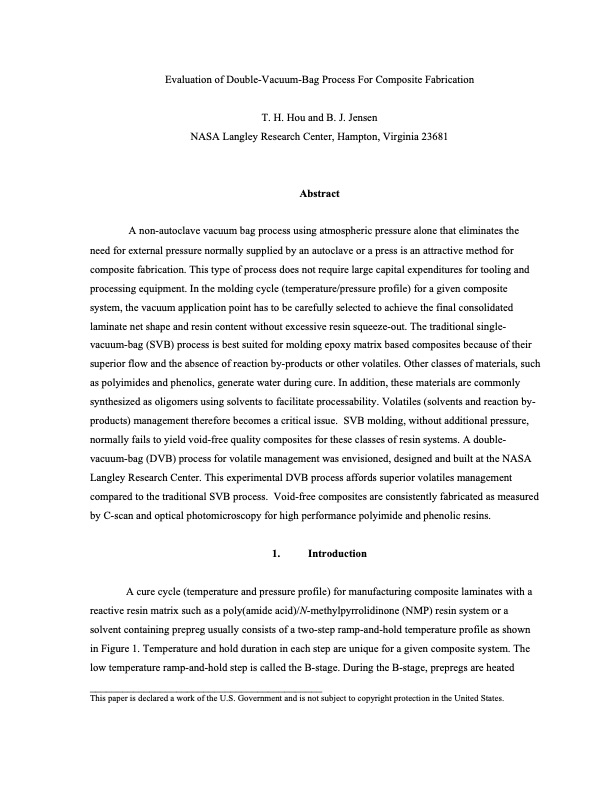
PDF Publication Title:
Text from PDF Page: 001
Evaluation of Double-Vacuum-Bag Process For Composite Fabrication T. H. Hou and B. J. Jensen NASA Langley Research Center, Hampton, Virginia 23681 Abstract A non-autoclave vacuum bag process using atmospheric pressure alone that eliminates the need for external pressure normally supplied by an autoclave or a press is an attractive method for composite fabrication. This type of process does not require large capital expenditures for tooling and processing equipment. In the molding cycle (temperature/pressure profile) for a given composite system, the vacuum application point has to be carefully selected to achieve the final consolidated laminate net shape and resin content without excessive resin squeeze-out. The traditional single- vacuum-bag (SVB) process is best suited for molding epoxy matrix based composites because of their superior flow and the absence of reaction by-products or other volatiles. Other classes of materials, such as polyimides and phenolics, generate water during cure. In addition, these materials are commonly synthesized as oligomers using solvents to facilitate processability. Volatiles (solvents and reaction by- products) management therefore becomes a critical issue. SVB molding, without additional pressure, normally fails to yield void-free quality composites for these classes of resin systems. A double- vacuum-bag (DVB) process for volatile management was envisioned, designed and built at the NASA Langley Research Center. This experimental DVB process affords superior volatiles management compared to the traditional SVB process. Void-free composites are consistently fabricated as measured by C-scan and optical photomicroscopy for high performance polyimide and phenolic resins. 1. Introduction A cure cycle (temperature and pressure profile) for manufacturing composite laminates with a reactive resin matrix such as a poly(amide acid)/N-methylpyrrolidinone (NMP) resin system or a solvent containing prepreg usually consists of a two-step ramp-and-hold temperature profile as shown in Figure 1. Temperature and hold duration in each step are unique for a given composite system. The low temperature ramp-and-hold step is called the B-stage. During the B-stage, prepregs are heated ___________________________________________ This paper is declared a work of the U.S. Government and is not subject to copyright protection in the United States.PDF Image | Evaluation of Double-Vacuum-Bag Process For Composite Fabrication

PDF Search Title:
Evaluation of Double-Vacuum-Bag Process For Composite FabricationOriginal File Name Searched:
Double-Vacuum-Bag-Process-Composite-Fabrication.pdfDIY PDF Search: Google It | Yahoo | Bing
5,000 BF Shipping Container Lumber Dry Kiln For Quality Lumber The 5,000 BF container kiln consists of one 40 foot high-cube aluminum shipping container... More Info
Shipping Container Lumber Dry Kilns by Global Energy Global Energy designed and developed the container kiln back in 1991. The purpose is to give access to portable sawmill owners, furniture makers, and small business the value added profit of dry kiln lumber and quality hardwoods... More Info
Vacuum Kiln Conversion Kit for Lumber and Wood Dry Kilns Convert your existing conventional dry kiln into a fast drying vacuum kiln. Similar to vacuum bagging in the boat building and aircraft industry, we have come up with a proprietary process which allows you to build a very simple vacuum kiln at a fraction of the price, and without the intensive conventional metal chamber structure... More Info
Vacuum Pump Cart System for Bagging Clamping Wood Drying and more Vacuum Cart with 2HP Pump and Dual Pistons with multiple multiplex vacuum ports and liquid reservoir... More Info
Vacuum Bagging Basics Vacuum bagging is a method of clamping, which has traditionally been used in the composites industry, but can also be used for vacuum drying materials, including wood products... More Info
| CONTACT TEL: 608-238-6001 Email: greg@globalmicroturbine.com | RSS | AMP |